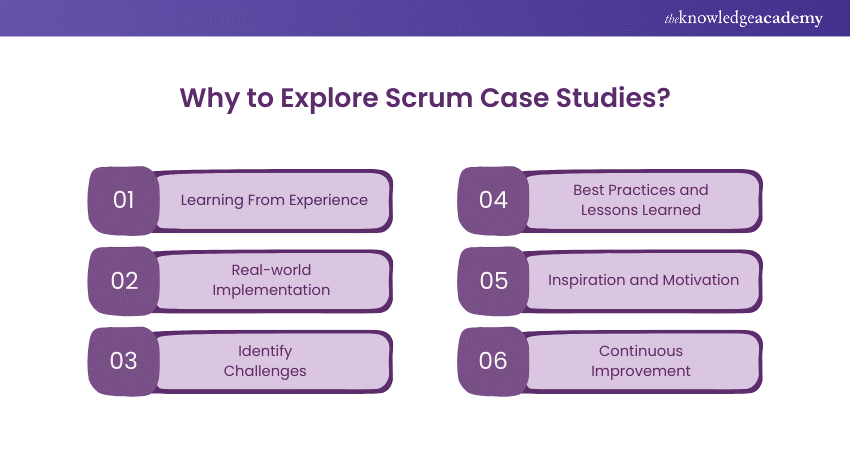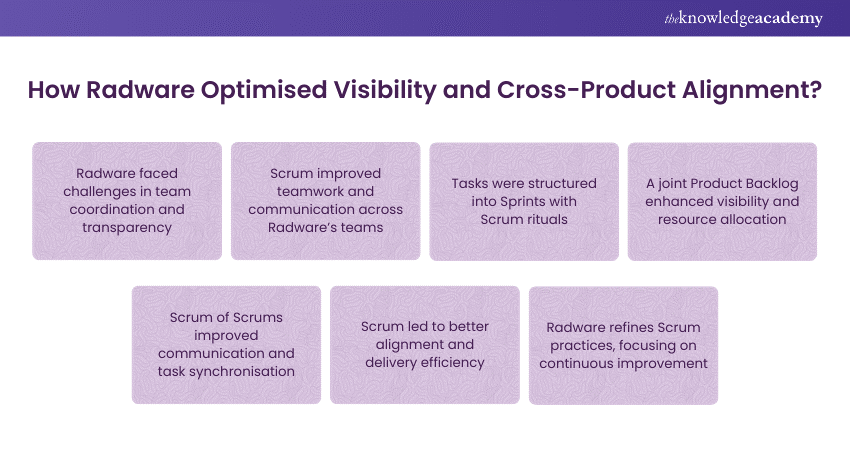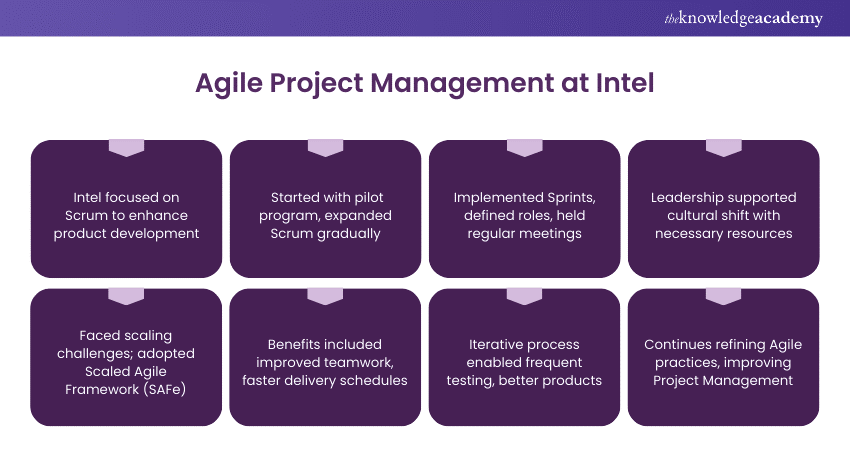We may not have the course you’re looking for. If you enquire or give us a call on + 1-866 272 8822 and speak to our training experts, we may still be able to help with your training requirements.
We ensure quality, budget-alignment, and timely delivery by our expert instructors.

Scrum Case Studies provide valuable perspectives on the implementation of the Scrum framework in actual projects. They offer in-depth examinations of accomplishments, obstacles, and insights gained. The examples in this blog demonstrate how Scrum can lead to enhanced team cooperation, more efficient processes, and improved project results. By studying practical cases, experts can learn how to apply Scrum principles to their specific circumstances.
If you're a beginner in Scrum or aiming to improve your strategy, these case studies can be a useful resource for guidance. They provide practical tips that can be put into practice to improve your team's productivity and performance in Project Management.
Table of Contents
1) Importance of Case Studies in Scrum
2) Examples of Scrum Case Study
a) Mayden's Transformation from Waterfall to Scrum
b) Scrum Methodology as Used by a Capstone Team
c) Increasing visibility and cross-product alignment at Radware
d) Effects of Scrum, Nine months later
e) Blue Flash Conversion to Scrum Practices
f) Agile Project Management at Intel – A Scrum Odyssey
3) Conclusion
Importance of Case Studies in Scrum
Case studies play a crucial role in Scrum by providing actual scenarios and perspectives on how the framework can be put into practice. Let’s explore what makes Scrum Case Studies so important.

1) Learning from Experience: Practical Application Scrum Master Case Studies offer valuable lessons from others' encounters with Scrum, uncovering obstacles, remedies, and implementation paths.
2) Real-world Implementation: These instances demonstrate the practical application of Scrum principles and practices.
3) Identify Challenges: Scrum examples assist in foreseeing challenges, enabling teams to plan tactics for overcoming possible hurdles.
4) Best Practices and Lessons Learned: Case studies offer best practices and lessons learned to help with effective Scrum implementation and avoid common mistakes.
5) Inspiration and Motivation: It encourage and drive teams by demonstrating positive results accomplished through implementing Scrum.
6) Continuous Improvement: Scrum case studies help enhance Scrum practices by providing feedback and insights to the Scrum community, thus contributing to ongoing improvement.
Overall, case studies of Scrum Masters offer valuable insights, inspiring ideas, and helpful advice for effective Scrum adoption and ongoing enhancement. By integrating these case studies, a thorough grasp of Scrum and how it is applied in real-world scenarios is achieved.
Examples of Scrum Case Study
Explore real-world applications of Scrum through detailed case studies. These examples showcase how Scrum enhances Project Management across various industries.
1) Mayden's Transformation from Waterfall to Scrum
Mayden, a healthcare technology company, went through a major change by transitioning from the conventional Waterfall approach to Scrum. The organisation faced challenges due to the rigidity of Waterfall, impacting their capacity to adjust to changing needs and provide updates on time. The move to Scrum was driven by the desire for a Project Management approach that is more iterative and flexible.
Mayden's initial phase of transformation involved teaching their teams about Scrum principles and practices. This included thorough training sessions and workshops to make sure all individuals grasped the new methodology. The transformation necessitated a shift in culture for the organisation, focusing on collaboration, transparency, and ongoing improvement.
Mayden's teams-initiated Scrum by incorporating Sprints, frequent meetings, and well-defined positions like Scrum Master and Product Owner. The company encountered initial difficulties including pushback against change and the necessity to reshape team responsibilities. Yet, these obstacles were effectively dealt with by consistent coaching and assistance.
As the teams became more accustomed to Scrum, they observed notable enhancements in their Scrum workflow. The iterative process of Scrum enabled more effective management of requirement changes, resulting in quicker delivery times and better-quality products. Enhanced communication and collaboration among departments was also boosted by the increased transparency in the process.
In general, Mayden's adoption of Scrum led to a more agile and responsive organisation. The company improved its product delivery efficiency, quickened responses to customer needs, and encouraged a culture of ongoing enhancement.
Master Scrum development skills with our Scrum Developer Training – Register today!
2) Scrum Methodology as Used by a Capstone Team
A group of students from a University Capstone program decided to utilise Scrum methodology for overseeing their final project, which included the creation of a sophisticated software application. The team decided to use Scrum due to its adaptability and capacity to manage the project's changing needs.
The Capstone project started by establishing the Scrum framework, which involved outlining the Product Backlog, setting up Sprints, and assigning team roles. Every team member was assigned tasks, while one member assumed the role of Scrum Master to lead the process.
The team needed help in efficiently managing time and ensuring that all members were aligned. They tackled these problems by conducting daily stand-up meetings, in which they talked about advancements, pinpointed challenges, and strategised the tasks for the day. This method ensured clarity and helped the team remain focused on their objectives.
As the project advanced, the team continuously refined their software through feedback and testing. Utilising Scrum enabled them to remain adaptable and implement essential adjustments without causing any delays to the project schedule.
At the conclusion of the Capstone project, the team effectively handed over a fully operational software application that had been thoroughly tested. The use of the Scrum methodology assisted them in time management, maintaining organisation, and producing a top-notch product, showcasing its efficacy within an academic environment.
3) Increasing Visibility and Cross-product Alignment at Radware
Radware, a worldwide supplier of cyber security solutions, encountered difficulties in coordinating its numerous product teams and enhancing transparency throughout projects. The organisation implemented Scrum to tackle these problems and improve teamwork across its teams.

Radware adopted Scrum for its product teams to enhance transparency and boost communication among different teams. They started by structuring their tasks into Sprints and hosting consistent Scrum rituals like Sprint Planning, Daily Stand-ups, and Sprint Retrospectives. These methods aided in aligning the actions of various teams, ensuring that all were striving towards identical objectives.
One significant change was the implementation of a joint Product Backlog, enabling all teams to view and comprehend the priorities throughout the organisation. This enhanced visibility aided in improved resource distribution and avoided redundant efforts.
Radware also implemented the Scrum of Scrums approach, which helped in enhancing communication among Scrum teams. This method enabled the synchronisation of tasks among various products, ensuring that all teams were on the same page and operating effectively.
Implementing Scrum led to enhanced alignment across products and increased insight into project advancement. Radware's teams improved product delivery efficiency by having a firmer grasp on priorities and enhancing communication between departments. The company is constantly improving its Scrum practices, with a focus on collaboration and continuous improvement.
4) Effects of Scrum, Nine Months Later
A technology firm chose to implement Scrum to enhance its Software Development procedure. After nine months of implementing Scrum, the company carried out an evaluation to analyse its effects.
The beginning stage of implementing Scrum included educating the teams, establishing Sprints, and clarifying roles. The company encountered obstacles like reluctance to change and the requirement to adapt to a different work approach. Nevertheless, these obstacles were eventually surmounted with ongoing coaching and assistance from the leadership.
After nine months of following the Scrum method, the company noticed numerous improvements. Teams noted enhanced communication and teamwork, along with a better grasp of their duties and obligations. The repetitive process of Scrum resulted in quicker feature delivery and more frequent releases, resulting in improved customer satisfaction.
The evaluation also pointed out areas that could be improved, like the necessity for improved backlog management and increased emphasis on continuous improvement. The company tackled these problems by improving its Scrum techniques and providing extra training for its teams.
In general, implementing Scrum improved the company's software development process. The teams improved in agility, responsiveness, and readiness to accommodate changes in requirements. The company still utilises Scrum, with a focus on constant improvement and providing top-notch products to clients.
Empower team collaboration and efficiency with our with Scrum Team Course – Sign up today!
5) Blue Flash Conversion to Scrum Practices
Blue Flash, a digital marketing agency, implemented Scrum methodologies to enhance its Project Management and delivery procedures, a useful approach for those starting a Digital Marketing Agency to streamline operations. The organisation faced challenges in meeting deadlines and managing client expectations, which led to the choice to switch to Scrum.
The process of conversion started by educating the teams on the principles and practices of Scrum. Blue Flash established its Scrum framework by laying out roles, setting up Scrum Sprints, and structuring the Product Backlog. The organisation also assigned Scrum Masters to lead the teams during the change.
Implementing Scrum practices resulted in multiple advantageous changes at Blue Flash. The teams grew more structured and concentrated, with well-established objectives and duties. Utilising Sprints enabled more manageable tasks and improved scheduling, leading to projects being delivered on time.
Enhanced client communication was a key advantage of utilising Scrum. The repeated cycle enabled continuous input and modifications, ensuring the result matched the client's needs. The openness in the process also fostered trust with clients, resulting in deeper relationships and recurring business.
Blue Flash's implementation of Scrum methodologies led to a more streamlined and productive Project Management process. The organisation managed to complete projects of superior quality, meeting deadlines and exceeding client expectations. The ongoing use of Scrum is due to its successful adoption, with an emphasis on constantly improving and perfecting methods.
6) Agile Project Management at Intel – A Scrum Odyssey
Intel, a top technology company, began implementing Agile Project Management methods, specifically focusing on Scrum. The company sought to enhance its product development process, promote collaboration, and streamline the delivery of innovative products.

Intel's path started with a trial program, in which a compact group was educated in Scrum and assigned to apply it in a product development phase. The pilot's success resulted in Scrum being gradually embraced by other teams and departments.
Introducing Scrum at Intel included establishing Sprints, outlining responsibilities, and hosting frequent Scrum meetings. The company emphasised the importance of promoting teamwork and ongoing enhancement. The leadership supported the cultural shift by providing the required resources and support for the transition.
Intel encountered a significant obstacle in implementing Scrum practices across extensive and varied teams. The company tackled this issue by implementing the Scaled Agile Framework (SAFe), enabling improved coordination and alignment among numerous teams.
Implementing Scrum at Intel led to various beneficial results. The teams indicated enhanced cooperation, quicker delivery schedules, and improved synchronisation with customer requirements. The process of iteration also permitted more frequent testing and feedback, resulting in products of better quality.
Intel is continually perfecting its Agile practices and searching for innovative ways to enhance its Project Management process as part of its ongoing Scrum journey. The effectiveness of Scrum in managing complex projects and delivering innovative products in a fast-paced industry has been proven with the success of Intel.
Conclusion
In conclusion, Scrum Case Studies offer essential perspectives on how Scrum is used in various industries. They showcase the difficulties, achievements, and knowledge gained from actual projects. Through analysing these instances, teams can gain a deeper comprehension of how to successfully apply Scrum, conquer challenges, and consistently enhance their methodologies. If you are a beginner in Scrum or aiming to improve your methods, these case studies can help you succeed in Agile Project Management.
Become a successful Scrum team leader with our Certified Scrum Master Course – Register now!
Frequently Asked Questions
What are the 3 Pillars of Scrum?

Scrum is based on three main principles: Transparency, Inspection, and Adaptation. Transparency ensures that the process is visible to all. Regular examinations are required for monitoring progress, while flexibility enables the team to make necessary adjustments according to feedback.
Who Should Use Scrum?

Scrum is well-suited for teams dealing with complicated projects, especially in Software Development, but it is also advantageous for any sector that needs flexibility, gradual advancement, and teamwork.
Who Controls Scrum?

Scrum is not controlled by a single person; it requires a collaborative effort from the team. The Scrum Master aids in the process, the Product Owner assigns work priority, and the Development Team works together to complete the product.
What are the Other Resources and Offers Provided by The Knowledge Academy?

The Knowledge Academy takes global learning to new heights, offering over 3,000 online courses across 490+ locations in 190+ countries. This expansive reach ensures accessibility and convenience for learners worldwide.
Alongside our diverse Online Course Catalogue, encompassing 19 major categories, we go the extra mile by providing a plethora of free educational Online Resources like News updates, Blogs, videos, webinars, and interview questions. Tailoring learning experiences further, professionals can maximise value with customisable Course Bundles of TKA.
What is The Knowledge Pass, and How Does it Work?

The Knowledge Academy’s Knowledge Pass, a prepaid voucher, adds another layer of flexibility, allowing course bookings over a 12-month period. Join us on a journey where education knows no bounds.
What are the Related Courses and Blogs Provided by The Knowledge Academy?

The Knowledge Academy offers various Scrum Certification, including the Scrum Master Certification, Scrum For Teams, and Scrum Overview. These courses cater to different skill levels, providing comprehensive insights into Scrum Theory.
Our Project Management Blogs cover a range of topics related to Scrum, offering valuable resources, best practices, and industry insights. Whether you are a beginner or looking to advance your Project Management skills, The Knowledge Academy's diverse courses and informative blogs have got you covered.
Upcoming Project Management Resources Batches & Dates
Date
 Scrum Master Certification
Scrum Master Certification
Thu 20th Feb 2025
Thu 13th Mar 2025
Thu 1st May 2025
Thu 12th Jun 2025
Thu 7th Aug 2025
Thu 18th Sep 2025
Thu 27th Nov 2025
Thu 18th Dec 2025






 Top Rated Course
Top Rated Course



 If you wish to make any changes to your course, please
If you wish to make any changes to your course, please


